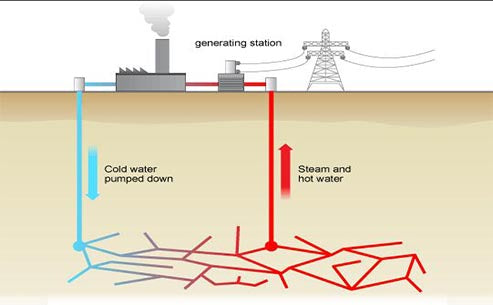
Enhanced Geothermal System (EGS—Enhanced Geothermal Systems) refers to an artificial geothermal system that economically exploits deep thermal energy from low-permeability rock masses of 3 to 10 kilometers underground.
The enhanced geothermal system is proposed on the basis of hot dry rock technology. The U.S. Department of Energy defines it as an artificial geothermal system that uses the method of artificially forming a geothermal reservoir to economically recover a substantial amount of deep thermal energy from a low-permeability rock mass. The enhanced geothermal system realizes circulation in the ground by injecting water from the man-injection well, enters the artificially generated, open and connected fracture zone, and the water contacts the rock mass to be heated, and then returns to the surface through the production well to form a closed loop. The concept itself is a simple extrapolation, imitating naturally occurring hot water-type geothermal circulation systems—the systems that are now used commercially to produce electricity and directly utilize thermal energy in about 71 countries around the world.
The first step in establishing an enhanced geothermal system is to conduct exploration to identify and identify the most suitable development blocks. Then drill holes to a sufficient depth to reach usable rock mass temperatures to further verify and quantify specific resources and corresponding development depths. If a low permeability rock mass is encountered, it is hydraulically fractured to create the bulk water reservoir required for heat recovery and to achieve proper communication with the injector-producer system. If the drilled rock mass has sufficient natural permeability within limited geometrical boundaries, the heat recovery process may employ well-established methods similar to water flooding or steam flooding used in oil production. Other heat recovery options include downhole heat exchangers or heat pumps, or alternate injection and production (huff and puff) methods. EGS power plants have no greenhouse gas emissions in operation, moderate land use, small overall environmental impact, low cost, and relatively mature technology, which has the potential for further development.

The EGS system eliminates the risk of "dry drilling" conventional geothermal systems and does not require construction on sites with conventional geothermal resources. The enhanced geothermal system has the characteristics of huge thermal energy reserves, high utilization efficiency, and system stability. The difference between EGS and traditional geothermal systems is that it can dig deep underground (about 3.6-9 kilometers) geothermally enhanced geothermal systems (EGS) to generate electricity without any geographical restrictions. To put it simply, it is to use water flow as a carrier to inject cold water into the hot rock formation and heat it to generate high-temperature steam. Using proprietary technology, the continuous high-temperature steam is lifted to the ground, and then the steam drives the turbine generator to generate electricity to generate electricity, which is transported to the ground. power grid. At the same time, the discharged residual warm water can also be sent to the heating pipeline for local residents' heating and other daily life purposes.
In 2007, a study by the Massachusetts Institute of Technology indicated that within the next 50 years, EGS systems could provide 10% of the world's electricity at prices competitive with fossil fuels such as coal. In addition, according to the conclusions drawn by the Massachusetts Institute of Technology in the United States and MMA in Australia, the cost of EGS power generation is also lower than that of other forms of renewable energy, so EGS power generation is very cost-competitive.
Recently, the international voice for the development of EGS has become increasingly loud. Not only has the United States, Germany, France, Australia, Japan, Switzerland and other countries also built a number of experimental EGS systems, but China's EGS research is basically blank. The Chinese Academy of Sciences has clearly listed EGS as a key research field in the 12th Five-Year Plan. In order to promote the EGS research of the Chinese Academy of Sciences and further play the leading role of the Chinese Academy of Sciences in the field of national energy and environmental science and technology, on April 21, 2010, sponsored by the High Technology Bureau and the Bureau of Resources and Environment of the Chinese Academy of Sciences, Guangzhou Energy Research Institute of the Chinese Academy of Sciences, Renewable Energy and Energy of the Chinese Academy of Sciences. The "Enhanced Geothermal System (EGS) Symposium" organized by the Key Laboratory of Natural Gas Hydrates and co-organized by the Geothermal Professional Committee of the Chinese Geophysical Society was held in Guangzhou Energy Institute.
The participants exchanged and discussed about China's EGS research goals, key scientific issues, key research contents and key technologies. Through exchanges and discussions, the participating experts agreed that EGS research and development is a highly comprehensive and highly visible work. , China has the strength and foundation in this regard, and the conditions are basically in place. It is recommended that the relevant state departments establish a project as soon as possible, carry out EGS resource potential evaluation, mining mode, production capacity analysis and technical and economic feasibility evaluation, and solve the formation of deep artificial thermal storage, downhole pumps, fractures Key technologies such as feature description, high-temperature logging tools and sensors, fluid imaging, excitation prediction model, tracer and tracer data interpretation, interlayer sealing and power generation have laid the foundation for the development and utilization of the entire EGS process.















